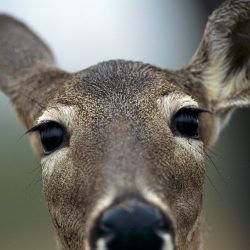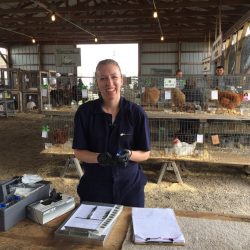By Kathryn Kesler

As a DVM student who is interested in large animal medicine, I often hear people say, “Veterinary medicine is a dying field.” But, after talking with these individuals, I quickly realized that they believe the role of a large animal veterinarian is only to palpate (check for pregnancy) and administer shots. Based on these beliefs, they would be completely right; if my future job relied solely on my physical skill set, veterinary medicine would be a dying field.
The reality is that it is far cheaper for a producer to train an employee how to palpate, give injections, and diagnose common illnesses than it is for them to call a veterinarian every time they need to give a cow a shot. But, fortunately for myself and thousands of other current and future veterinarians, our job security lies not with our hands, but within our heads.
When I finish my tenure at MSU’s College of Veterinary Medicine, I will have been given all of the proficiency necessary to be able to understand, diagnose, treat, and prevent the medical ailments of animals. As all producers understand, healthy animals are more productive, more economical, and have a higher quality of life. As a veterinarian, I can make recommendations to a farmer that will improve udder health within their herd, which will decrease the rate of mastitis (an infection of the mammary gland of a mammal). This leads to more milk production and, more importantly, higher quality milk.

I also can make recommendations to a producer to decrease the incidence of respiratory infections in their beef cattle. This means the producer will have to use fewer antibiotics, resulting in more productive cattle. I can make recommendations to a producer on how to decrease their pre-weaning mortality in a farrowing facility, which means more pigs going to market. All of these things contribute to global food security by producing a higher quality and a less expensive product. When I graduate, I will have many clinical skills that will be valuable to producers, but even more valuable will be my ability to assess situations and think critically about a course of action.
So, how does all of this relate to society? How many times today have you eaten food? How many times today did you wear or use a textile? Agriculture is an integral part of our society. It is the role of veterinarians to ensure the sustainability of agriculture. Whether its more judicious antimicrobial usage to minimize antibiotic resistance in both humans and animals or decreasing the greenhouse gas emissions from cattle to become more environmentally conscious, veterinarians have a vital role in ensuring that agriculture is economically, socially, and environmentally sustainable. With many consumer driven initiatives in the agriculture industry, it is the role of the veterinarian to not only mitigate consumer and producer relations, but, most importantly, protect the animals.
Consumers are pushing producers to move away from using antibiotics. It is the role of veterinarians to help producers find managerial practices that can compensate for the decreased use of antibiotics, while simultaneously educating consumers about how these antibiotics can save lives. When a calf has severe pneumonia, an antibiotic could be what saves its life and prevents its pen mates from getting sick as well. So, it is the role of the veterinarian to facilitate the understanding of what judicial antimicrobial usage means for producers and consumers alike, and to ensure that, at the end of the day, animal health and welfare is the number one priority.
So, when people tell me that veterinary medicine is a dying field, I feel sorry for them because they are not aware of everything that veterinarians are capable of. I envision a future when veterinarians ensure agricultural practices are economically, socially, and environmentally sustainable, and animal welfare is on the forefront of industry—a future when veterinarians get paid fairly and are valued not only for the products of their hands, but also for their intellectual contributions to the practices and values of the agricultural industry.



